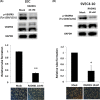c-Myc promotes lymphatic metastasis of pancreatic neuroendocrine tumor through VEGFC upregulation
- PMID: 33128283
- PMCID: PMC7780026
- DOI: 10.1111/cas.14717
c-Myc promotes lymphatic metastasis of pancreatic neuroendocrine tumor through VEGFC upregulation
Abstract
Pancreatic neuroendocrine tumor (pNET) is a pancreatic neoplasm with neuroendocrine differentiation. pNET in early stage can be treated with surgical resection with long-term survival, whereas the prognosis of pNET with locoregional or distant metastasis is relatively poor. Lymphangiogenesis is essential for tumor metastasis via the lymphatic system and may overhead distant metastasis. c-Myc overexpression is involved in tumorigenesis. The role of c-Myc in lymphangiogenesis is unclear. In this study, we evaluated the mechanism and effect of c-Myc on lymphangiogenesis of pNET via interaction of lymphatic endothelial cells (LECs) and pNET cells. Lymph node metastasis was evaluated in pNET xenograft mice. Potential target agents to inhibit lymph node metastasis were evaluated in an animal model. We found that vascular endothelial growth factor C (VEGFC) expression and secretion was increased in pNET cell lines with c-Myc overexpression. c-Myc transcriptionally upregulates VEGFC expression and the secretion of pNET cells by directly binding to the E-box of the VEGFC promoter and enhances VEGF receptor 3 phosphorylation and the tube formation of LECs. c-Myc overexpression is associated with lymph node metastasis in pNET xenograft mice. Combinational treatment with an mTOR inhibitor and c-Myc inhibitor or VEGFC-neutralizing chimera protein reduced lymph node metastasis in the mice with c-Myc overexpression. The mTOR inhibitor acts on lymphangiogenesis by reducing VEGFC expression in pNET cells and inhibiting the tube formation of LECs. In conclusion, mTOR and c-Myc are important for lymphangiogenesis of pNET and are potential therapeutic targets for prevention and treatment of lymph node metastasis in pNET.
Keywords: c-Myc; lymphangiogenesis; mTOR; pancreatic neuroendocrine tumor; vascular endothelial growth factor C.
© 2020 The Authors. Cancer Science published by John Wiley & Sons Australia, Ltd on behalf of Japanese Cancer Association.
Conflict of interest statement
The authors disclosed no financial conflict of interests.
Figures






References
-
- Birnbaum DJ, Turrini O, Ewald J, et al. Pancreatic neuroendocrine: a multivariate analysis of factors influencing survival. Eur J Surg Oncol. 2014;40:1564‐1571. - PubMed
MeSH terms
Substances
Grants and funding
LinkOut - more resources
Full Text Sources
Medical
Miscellaneous

